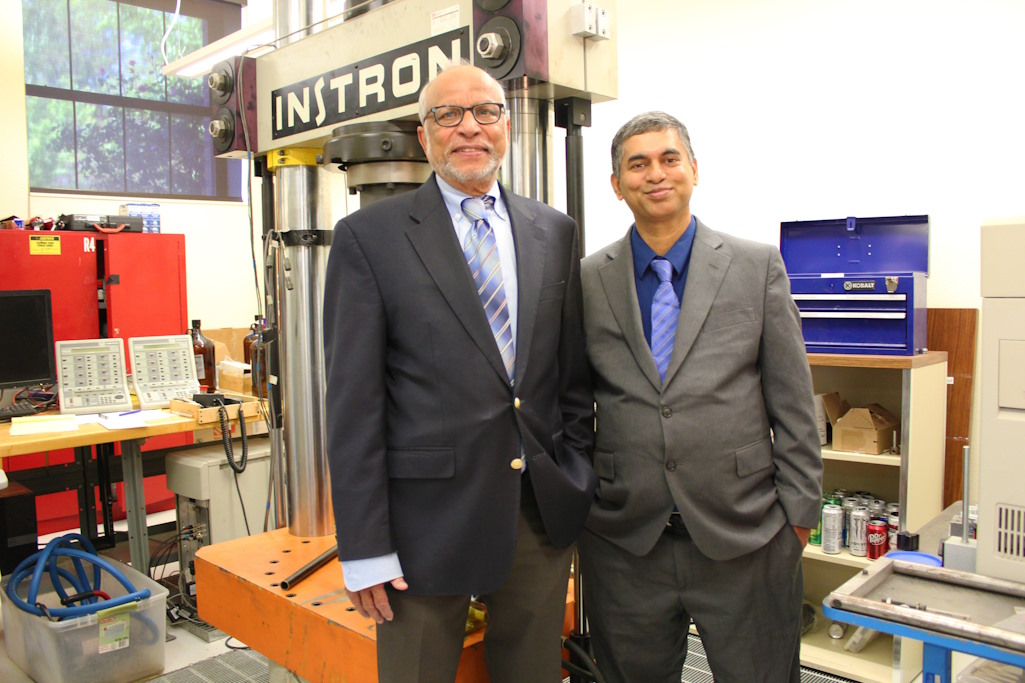
Pradeep Menezes and Mano Misra lead the USD 500,000 NRC-funded project.
The University of Nevada, Reno (USA) Engineering Faculty is researching solutions for the safe storage of spent nuclear fuels. A new process has been developed to repair containers used to store nuclear fuel, increasing safety.
Text & image by University of Nevada, Reno
Mechanical Engineering Associate Professor Pradeep Menezes and Chemical & Materials Engineering Professor Mano Misra have been awarded a USD 500,000 Nuclear Regulatory Commission (NRC) grant for their project to strengthen storage canisters used for nuclear waste.
The project, “Manufacturing of Spent Fuel Storage Canisters with Superior Stress Corrosion Cracking Resistance using Advanced Hybrid Laser-Arc Welding and High-Pressure Cold Spray Additive Post-Processing,” was funded in early 2024. This project addresses chloride-induced stress corrosion cracking (CISCC) of stainless-steel containers used to store used nuclear fuel. The professors say their work promises to significantly advance nuclear safety and engineering, ensuring a more secure future for nuclear waste management.
“The project will elevate the University’s visibility in nuclear science and engineering both nationally and globally,” Menezes said.
The research also involves graduate students and provides opportunities for undergraduates from minority-serving institutions, fostering the development of the next-generation workforce in nuclear science and engineering.
Novel concept put into action
The United States currently has over 80,000 metric tons of spent nuclear fuels stored in approximately 1,500 dry storage canisters across 63 independent interim storage locations. With storage durations expected to exceed 50 years, these canisters, made from a special type of welded stainless steel, face significant challenges. Over time, these canisters are exposed to environments where salty liquids that attract moisture from the air form on the surfaces of containers, leading to CISCC. Such failures could eventually cause nuclear radiation leakage, endangering nearby populations.
Historically, gas metal arc welding (GMAW) has been used to repair CISCC in the fusion-welded regions of the dry storage canisters. However, GMAW involves high heat input, melting and solidification, which are undesirable for the safety of on-site canister manufacture and repair.
Menezes and Misra’s research introduces a novel concept combining advanced hybrid laser-arc welding (HLAW) with high-pressure cold spray (HPCS) post-processing. This HPCS additive deposition method enhances surface structural integrity by using the kinetic energy of powder particles, which impinge on the substrate at high velocity and pressure. Unlike traditional thermal energy-based methods, HPCS does not generate thermal stress, oxidation or other detrimental effects, making it a cost-competitive alternative. The proposed technique is expected to significantly enhance the performance of dry storage canisters, delaying CISCC initiation and propagation.
The HLAW process is anticipated to produce weld joints with superior resistance to pitting corrosion and CISCC compared to conventional GMAW joints. Additionally, the HPCS coating acts as a barrier, further mitigating CISCC. The enhanced resistance and longevity of the dry storage canisters achieved through this research could save millions of dollars in repair and rework costs, while also increasing safety and security for spent nuclear fuels storage applications. The project involves both experimental and computational work.
Related work with the DOE
Misra and Menezes have been collaborating for the past three years on a similar project funded by the US Department of Energy, which is responsible for research and development into the long-term disposition of spent nuclear fuel.
This other project, supported by USD 799,000 in DOE funding, focuses on mitigating stress corrosion cracking in nuclear storage canisters through various peening techniques. The project offers an alternative approach to extending the lifespan of the welded areas in dry storage casks by applying mechanical and thermal peening techniques.
About the researchers
Menezes brings over 20 years of research experience in surface modification techniques, degradation analysis, HPCS and finite element modeling. He has written over 180 refereed journal publications, 10 books and holds one issued US patent. Recognized as a leading scientist, Menezes boasts a Google Scholar citation count exceeding 10,000 and an H-index of 50. He was listed among the top scientists by Research.com in its 2024 national rankings and is also featured in Elsevier’s top 2% of scientists worldwide, both for career-long and single-year contributions. Misra, with over 200 papers published in refereed journals and 14 issued US patents, is a longtime collaborator of Menezes’. Their partnership has previously secured several significant grants, including those from the National Science Foundation, NASA, the DOE’s Advanced Manufacturing Office and the Nuclear Energy University Program.
About this Tech Article
Appearing in the September 2024 issue of Stainless Steel World Magazine, this technical article is just one of many insightful articles we publish. Subscribe today to receive 10 issues a year, available monthly in print and digital formats. – SUBSCRIPTIONS TO OUR DIGITAL VERSION ARE NOW FREE.
Every week we share a new technical articles with our Stainless Steel community. Join us and let’s share your technical articles on Stainless Steel World online and in print.

